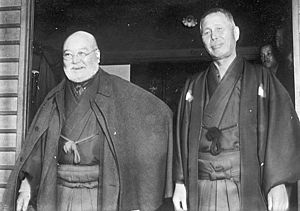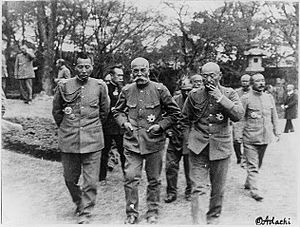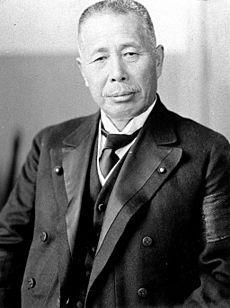Tanaka Giichi facts for kids
Quick facts for kids
Tanaka Giichi
|
|
|---|---|
|
田中 義一
|
|
 |
|
| Prime Minister of Japan | |
| In office 20 April 1927 – 2 July 1929 |
|
| Monarch | Shōwa |
| Preceded by | Wakatsuki Reijirō |
| Succeeded by | Osachi Hamaguchi |
| Minister of Foreign Affairs | |
| In office 20 April 1927 – 2 July 1929 |
|
| Prime Minister | Himself |
| Preceded by | Kijūrō Shidehara |
| Succeeded by | Kijūrō Shidehara |
| Minister of Colonial Affairs | |
| In office 10 June 1929 – 2 July 1929 |
|
| Prime Minister | Himself |
| Preceded by | Position created |
| Succeeded by | Genji Matsuda |
| Home Minister | |
| In office 4 May 1928 – 23 May 1928 |
|
| Prime Minister | Himself |
| Preceded by | Suzuki Kisaburō |
| Succeeded by | Mochizuki Keisuke |
| Army Minister | |
| In office 2 September 1923 – 7 January 1924 |
|
| Prime Minister | Yamamoto Gonnohyōe |
| Preceded by | Yamanashi Hanzō |
| Succeeded by | Ugaki Kazushige |
| In office 20 September 1918 – 9 June 1921 |
|
| Prime Minister | Hara Takashi |
| Preceded by | Ōshima Ken'ichi |
| Succeeded by | Yamanashi Hanzō |
| Personal details | |
| Born | 22 June 1864 Hagi, Chōshū Domain |
| Died | 29 September 1929 (aged 65) Tokyo, Japan |
| Resting place | Tama Reien Cemetery, Fuchū, Tokyo |
| Political party | Rikken Seiyūkai |
| Spouse | Tanaka Sute (1874–1937) |
| Alma mater | Imperial Japanese Army Academy Army War College |
| Signature |  |
| Military career | |
| Allegiance | |
| Service/ |
|
| Years of service | 1874–1924 |
| Rank | |
Baron Tanaka Giichi (error: {{nihongo}}: Japanese or romaji text required (help)) was an important Japanese leader. He was a general in the Imperial Japanese Army and also a politician. He served as a cabinet minister and was the Prime Minister of Japan from 1927 to 1929.
Contents
Early Life and Army Career
Tanaka was born on June 22, 1864, in Hagi, Japan. His family were low-ranking samurai (warriors). When he was 13, he took part in the Hagi Rebellion.
He was interested in politics from a young age. He worked on a village council and as a teacher. He joined the Imperial Japanese Army when he was 20 years old.
Military Training and Early Wars
Tanaka went to the Imperial Japanese Army Academy. He also graduated from the Army War College in 1892. He was a junior officer during the First Sino-Japanese War.
After the war, he went to Russia as a military helper. He became good friends with Takeo Hirose from the Japanese Navy. Tanaka learned to speak Russian very well. He practiced his Russian by going to a Russian Orthodox church.
Because he knew Russian, he was very helpful during the Russo-Japanese War. He worked with General Kodama Gentarō in Manchuria.
In 1906, Tanaka helped create a defense plan for Japan. The plan was so good that the Japanese Army used it until World War I. He also received an award called the Order of the Golden Kite.
Rising Through the Ranks
In 1910, Tanaka started a group for army veterans. He became a major general in 1911. He was put in charge of the Military Affairs Bureau. There, he suggested making the army bigger by adding two more groups of soldiers.
He received another award, the Order of the Sacred Treasure, in 1918. He became the Army Minister in Prime Minister Hara Takashi's government. He held this job from September 1918 to June 1921.
In 1920, he was promoted to full general. He also received the Order of the Rising Sun. He was given the title of danshaku (which means baron).
After a while, Tanaka faced some criticism. He resigned from his jobs and retired to his summer home.
Political Career
Tanaka returned as Army Minister in 1923. He served in the government of Yamamoto Gonnohyōe until January 1924.
After leaving the army, Tanaka was asked to lead the Rikken Seiyūkai political party in 1925. He also became a member of the House of Peers in 1926. He was supposed to become a Field Marshal, which is a very high army rank. However, he received a large payment for joining the political party, and so the promotion was stopped.
Becoming Prime Minister
Tanaka became the Prime Minister of Japan on April 20, 1927. This was during a time of money problems in Japan. He was also the Foreign Affairs Minister at the same time.
Later, he also took on other roles:
- Home Minister (May 4, 1928 to May 23, 1928)
- Colonial Affairs Minister (June 10, 1929 to July 2, 1929)
Domestic and Foreign Policies
In Japan, Tanaka tried to control groups he saw as a threat, like Communists. Many people were arrested during this time.
In foreign policy, Tanaka had different ideas from the leader before him. He believed in using military force if there were problems with Japanese people living in other countries. He also wanted to treat Manchuria and Inner Mongolia differently from the rest of China.
He sent troops to Shandong Province in China three times in 1927 and 1928. This was to stop Chiang Kai-shek from uniting China. These events are known as the Jinan Incident.
Resignation and Death
In 1928, a powerful army group called the Kwantung Army caused a big problem. They killed a leader in Manchuria named Zhang Zuolin. Tanaka was surprised by this and wanted the soldiers responsible to be punished. However, the military leaders wanted to keep it a secret.
Tanaka lost support and faced criticism from the Japanese parliament and even Emperor Hirohito. Because of this, Tanaka and his government resigned on July 2, 1929.

Tanaka was replaced by Hamaguchi Osachi. Tanaka died a few months later, on September 29, 1929. He received the Order of the Paulownia Flowers after his death. His grave is in the Tama Cemetery in Fuchū, Tokyo.
The Tanaka Memorial
In 1929, some people in China said that Tanaka had written a secret plan. This plan was called the "Tanaka Memorial Imperialist Conquest Plan." It supposedly suggested that Japan should take over Manchuria, Mongolia, and eventually all of China.
During World War II, a movie series called Why We Fight said this plan was real. It even claimed the plan included taking over America.
However, most historians today believe that this document was not real. They think it was a fake.
Awards and Honors
Tanaka Giichi received many awards and honors during his life and after his death.
Japanese Awards
- 1906 –
 Order of the Golden Kite, 3rd class
Order of the Golden Kite, 3rd class - 1918 –
 Grand Cordon of the Order of the Sacred Treasure
Grand Cordon of the Order of the Sacred Treasure - 1920 –
 Grand Cordon of the Order of the Rising Sun
Grand Cordon of the Order of the Rising Sun - 1929 –
 Order of the Paulownia Flowers
Order of the Paulownia Flowers
Awards from Other Countries
- 1914 –
 – Bulgaria, Order of Saint Alexander 2nd class
– Bulgaria, Order of Saint Alexander 2nd class - 1918 –
 – China, Order of the Striped Tiger, 2nd class
– China, Order of the Striped Tiger, 2nd class - 1927 –
 – Poland, Order of Polonia Restituta, Grand Cordon
– Poland, Order of Polonia Restituta, Grand Cordon - 1929 –
 – Denmark, Order of the Dannebrog, 1st class
– Denmark, Order of the Dannebrog, 1st class - 1929 –
 – UK, Knight Commander of The Most Distinguished Order of Saint Michael and Saint George (KCMG)
– UK, Knight Commander of The Most Distinguished Order of Saint Michael and Saint George (KCMG) - 1929 –
 – UK, Knight Grand Cross of The Most Excellent Order of the British Empire (GBE)
– UK, Knight Grand Cross of The Most Excellent Order of the British Empire (GBE)
See also
 In Spanish: Tanaka Giichi para niños
In Spanish: Tanaka Giichi para niños



